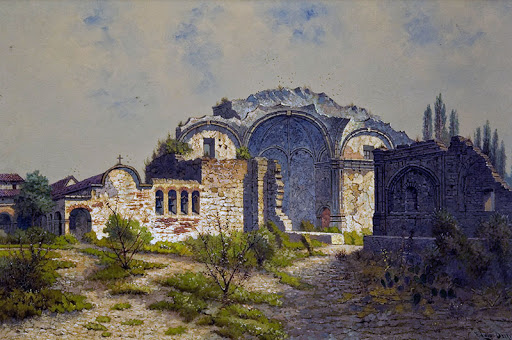Mission San Juan Capistrano was first founded on October 30, 1775, by Father Fermin Lasuen, abandoned because of rumors of Indian attacks and re-founded November 1, 1776, by Father Junipero Serra. The name Mission San Juan Capistrano honors Saint John of Capistrano, Italy..
Interesting Facts about Mission San Juan Capistrano
1775 - 1800
In 1775, Father Junipero Serra convinced Spanish Captain Rivera that a new mission was needed to break the long journey between San Diego and San Gabriel. On October 30, 1775, Father Fermin Lasuen founded San Juan Capistrano Mission, named for Saint John of Capistrano, Italy.
Just eight days later, word came that Indians attacked Mission San Diego de Alcala and killed one of the fathers. The fathers at San Juan Capistrano immediately returned to San Diego, but first Father Lasuen buried the San Juan Capistrano Mission bells to keep them safe.
The following year, Father Junipero Serra returned to San Juan Capistrano Mission, dug up the bells, and re-founded it on November 1, 1776.
The local Indians were friendly and helped the missionaries construct the buildings and church. In 1777, they built an adobe church. In 1791, the bells were moved from the tree where they had been hanging for 15 years into a new bell tower.
1800 - 1820
San Juan Capistrano Mission grew quickly and soon outgrew its small chapel. In 1797, they started a new building. Completed in 1806, it was the largest mission church in California.
 |
| 1886 |
1800 - 1820
San Juan Capistrano Mission grew quickly and soon outgrew its small chapel. In 1797, they started a new building. Completed in 1806, it was the largest mission church in California.
The most successful year at San Juan Capistrano Mission was 1811. That year, they grew 500,000 pounds of wheat and 303,000 pounds of corn. Livestock included 14,000 cattle, 16,000 sheep, and 740 horses.
In December 1812, an earthquake destroyed the church at San Juan Capistrano Mission. It killed 40 natives including two boys who were ringing the bells at the time. They did not rebuild the church.
In 1818, the pirate Bouchard attacked the California coast, saying he fought in the name of a South American province that was rebelling against Spain. Actually, he used the revolution as an excuse to attack the California settlements.
Padre Geronimo Boscano heard that the pirate was coming. He gathered the natives and fled. The Spanish guard tried to hold off the pirates, but they only succeeded in causing greater damage in the end.
1820 -1830
Mexico took over California in 1822. Governor Echeandia arrived in 1824; he said the Indians did not have to follow the commands of the fathers. Discipline began to break down. Then, Governor Figueroa tried to create a pueblo for free Indians at San Juan Capistrano, but it failed.
Secularization
In 1834, Mexico decided to end the mission system and sell the land. The 861 Indians who lived there did not want to stay.
1820 -1830
Mexico took over California in 1822. Governor Echeandia arrived in 1824; he said the Indians did not have to follow the commands of the fathers. Discipline began to break down. Then, Governor Figueroa tried to create a pueblo for free Indians at San Juan Capistrano, but it failed.
Secularization
In 1834, Mexico decided to end the mission system and sell the land. The 861 Indians who lived there did not want to stay.
From 1842 to 1845, not even a single priest was left. In 1845, Don Juan Forster, governor Pio Pico's brother-in-law bought San Juan Capistrano Mission. His family lived there for 20 years.
In 1863, President Abraham Lincoln returned the land to the Catholic church. However, San Juan Capistrano Mission was not kept up. In 1866, the Catholic church sent Father Jose Mut there. He found everything in ruins. The only building still standing was the chapel, which had a roof because it had been used to store hay. He tried to keep the buildings from getting worse, but he could do very little.
1900's
In 1910 Father John O'Sullivan came to San Juan Capistrano Mission. When he saw the condition of San Juan Capistrano Mission, he asked to take care of the ruins. Slowly, Father O'Sullivan started to restore it all by himself.
1900's
In 1910 Father John O'Sullivan came to San Juan Capistrano Mission. When he saw the condition of San Juan Capistrano Mission, he asked to take care of the ruins. Slowly, Father O'Sullivan started to restore it all by himself.
He traded bits of the ruined buildings for new materials, cut roof beams and hired Mexican workers to rebuild the adobe walls. In 1918, he got permission to make it an active church again, which it still is. The building and grounds are partly restored, and there is a museum.
San Juan Capistrano Mission is famous for its swallows, who fly south every year on October 23 and return on March 19. Legend says the swallows took up residence here to escape an innkeeper who kept destroying their nests. The swallows arrive at San Juan Capistrano Mission in groups and make their nests from mud and saliva, building them under the eaves of the buildings.



No comments:
Post a Comment